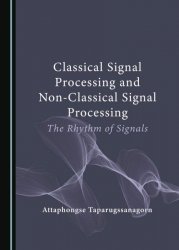 Название: Classical Signal Processing and Non-Classical Signal Processing: The Rhythm of Signals
Название: Classical Signal Processing and Non-Classical Signal Processing: The Rhythm of SignalsАвтор: Attaphongse Taparugssanagorn
Издательство: Cambridge Scholars Publishing
Год: 2023
Страниц: 229
Язык: английский
Формат: pdf (true)
Размер: 10.2 MB
Expertly unraveling the mysteries and allure of signals, this book explores their profound impact on modern life. From classical techniques to cutting-edge advancements, this comprehensive exploration delves into fundamental concepts such as amplitude, frequency, and phase. With meticulous research and insightful analysis, the author guides readers through topics like Fourier analysis, sampling, quantization, and signal filtering.The book highlights the dynamic relationship between time and frequency domains, statistical signal processing techniques, and the fascinating realm of non-classical signal processing, including wavelet transforms and compressed sensing, and explores diverse applications in audio, speech, image and video processing, biomedical analysis, communications, and sensor fusion.Highlighting emerging trends and future directions, the book illuminates the challenges, opportunities, and potential breakthroughs in signal processing research.
What sets this book apart is its unique perspective on presenting these concepts. It demonstrates how signals can be made sexy and valuable through the application of diverse signal processing techniques. It showcases signal processing as a powerful tool for extracting new information, transforming signals from mundane to captivating.
Classical signal processing is a branch of electrical engineering and applied mathematics that deals with the analysis, modification, and synthesis of signals. It encompasses various techniques for transforming, filtering, and analyzing signals to extract useful information or enhance their quality. The main goal of classical signal processing is to improve the performance and efficiency of systems that rely on signals, such as communication systems, audio and video processing, and control systems.
Classical signal processing consists of several fundamental techniques, including Fourier analysis, filtering, modulation, and digital signal processing. Fourier analysis is used to represent a signal in the frequency domain, allowing us to decompose it into its constituent frequencies. Filtering is the process of selectively removing or attenuating certain frequency components of a signal to extract or enhance specific features. Modulation involves manipulating a signal's amplitude, frequency, or phase to encode information or transmit it over a communication channel. Digital signal processing involves the use of computers to process signals in a discrete-time domain.
The applications of classical signal processing are widespread, and it hasrevolutionized several fields, including telecommunications, audio and video processing, and control systems. In telecommunications, signal processing techniques are used for modulation, encoding, decoding, and error correction in wireless communication systems, satellite communication systems, and optical communication systems. In audio and video processing, signal processing techniques are used for compression, noise reduction, and enhancement of audio and video signals.
In the chapter on non-classical signal processing, we delve into several important topics that expand beyond traditional signal processing approaches. Wavelet transforms and time-frequency analysis provide tools for studying signals that change over time. Compressed sensing and sparse signal processing techniques allow us to reconstruct and process signals using fewer measurements and leveraging their sparse representations. The application of Machine Learning and Deep Learning techniques to signal processing enables tasks like classification and prediction. Lastly, we explore signal processing techniques tailored for non-Euclidean data, such as graphs and networks. This chapter introduces innovative approaches that go beyond classical signal processing, empowering us to tackle complex and diverse signal analysis challenges.
Ideal for students, researchers, and industry professionals, “Classical Signal Processing and Non-Classical Signal Processing: The Rhythm of Signals” covers both theory and practice, providing readers with a comprehensive understanding of classical and non-classical signal processing techniques. The book offers a fresh and engaging approach, making the subject accessible and relevant to those working in emerging fields.
Скачать Classical Signal Processing and Non-Classical Signal Processing: The Rhythm of Signals